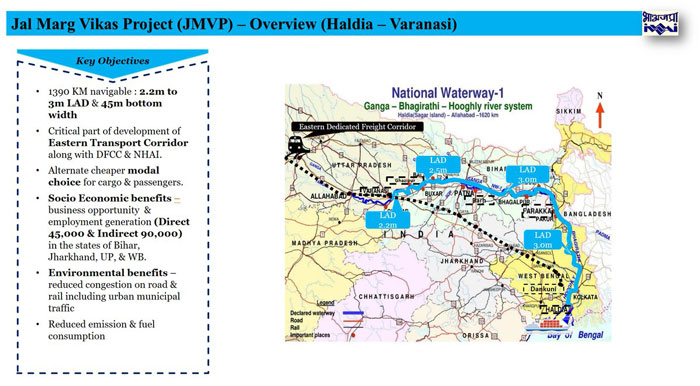By Nitesh Jindal, Dr. Ram Manohar Lohiya National Law University, Lucknow.
Jal Marg Vikas Project (JMVP) is a capacity augmentation project of navigation on National Waterway -1 (Allahabad-Haldia stretch of the Ganga-Bhagirathi-Hoogly River system). NW-1 is an inland waterway passing through the States of UP, Bihar, Jharkhand and West Bengal covering major cities like Kolkata, Patna, Howrah, Allahabad, Varanasi, etc. It is an ambitious project on river Ganga, the sole responsibility of development and regulation of which, has been given to the Inland Waterways Authority of India (IWAI).
BACKGROUND
A technical feasibility study for providing 3 metres Least Available Depth (LAD) in the stretch from Allahabad to Buxar on NW-1 was completed by DHI (India) Water and Environmental Pvt. Ltd. and this became the basis for IWAI to approach the Ministry of Shipping and Department of Economic Affairs for assistance. The necessary financial aid of Rs. 4200 crores was provided by the World Bank. Thereafter, this project was named in the Budget Speech as Jal Marg Vikas Project. JMVP will help India in various ways like growth in GDP, creation of various economic opportunities, decongestion of cargo traffic etc.
Inland Waterways Transport is highly underutilized in India, which has cost us an economic opportunity loss. As a means of transporting the cargo, it contributes just 0.1% to the total inland traffic in India (in Tonne Kilometers) while this figures stands at 21% in the USA. IWT in India has a modal share of merely 0.5% while in China, USA and Europe its share is 8.7%, 8.3% and 7% respectively. As is evident, all these countries are garnering socio-economic advantages through heavy investments in their IWT. While Germany in 2012 alone invested 12 billion Euros on its IWT, India has spent USD 250 million in a span of 28 years (1986-2014). This reflects India’s abysmally low level of investment in its Inland Waterways Transport. The development of IWT has never been given priority in our list of agendas, repercussions of which are still evident. JMVP will hopefully fix this lacuna and set forth the transport system in India to a new era.
OVERVIEW
JMVP aims to make NW-1 navigable and commercially viable for 1000-2000 Deadweight Tonnage (DWT) large cargo vessels through Fairway and Navigational Channel development. In order to achieve this, the foremost requirement would be to attain the ideal LAD. Due to hydro-morphological conditions in the upper reaches of NW-1 (Patna – Allahabad), IWAI is able to maintain only 2 metres of LAD and hence only 750 DWT capacity cargo vessels can navigate in the upper reaches.
For doing away with this difficulty, low draft vessels with large carrying capacity are being developed. These vessels are economically viable and environment friendly. As JMVP is a Capacity Augmentation Project, its development will help many stakeholders, especially Fertiliser, Shipping, Thermal Power Plant and Cement Companies, which will be able to move 1500-2000 DWT cargo in a single voyage.
JMVP has also outlined various infrastructure projects which will help our IWT in significant ways.
Construction of Multi-Modal Terminals at Varanasi, Sahibganj and Haldia, a new Navigational Lock at Farakka Barrage, development of Kolkata and Patna Terminals under PPP mode, construction of Ferry Terminals and development of River Information Services (RIS) are some of the major projects envisaged under JMVP.
A Multi-Modal Terminal helps in faster transit of goods, reduces cost of exports and improves competitiveness in the international market. IWAI should be appreciated for taking up a technologically challenging project like RIS, which will enhance swift electronic data transfer between mobile vessels’ base stations through real time exchange of information. It will also help in reducing the casualties in case of a calamity.
MAJOR BENEFITS OF JMVP
- The logistic cost of transport in India is as high as 18%. This is due to over dependence on the rail and road networks and undermining the utility of IWT. Once fully developed, JMVP will reduce India’s logistic costs to a considerable amount and thus will usher an era of development of the IWT.
- High dependence on rail and road networks has proved hazardous for the environment due to the rising levels of air, noise and land pollution. Under JMVP, modern inland vessels with LNG/CNG as fuel will be used, which will take the pressure off the rail and road networks, thereby ensuring reduced levels of carbon emission.
- Various employment and business opportunities will be generated. This in turn will bring down India’s economic opportunity cost, hence aiding the Gross Domestic Product (GDP) growth of the country.
- It is a non-water consumptive transportation project which will ultimately ensure minimum resource depletion.
- As the Project would serve various purposes, it will also boost the tourism industry thereby adding to the revenue of the government.
Jal Marg Vikas Project is undoubtedly of national significance as it has the potential to reduce the risk of environmental hazards, which have been a matter of concern at national as well as international platforms. IWAI as its implementation agency has a very crucial part to play in order to ensure effective enforcement and proper utilisation of this Project.
Moreover, achieving the Least Available Depth of 3 metres remains a challenge, as it requires activities such as dredging and bandalling in the upper reaches of the river. However, once attained, this will augment the capacity of navigable cargo vessels through NW-1, thereby bringing convergence between inland waterways and other modes of transport in the country.

